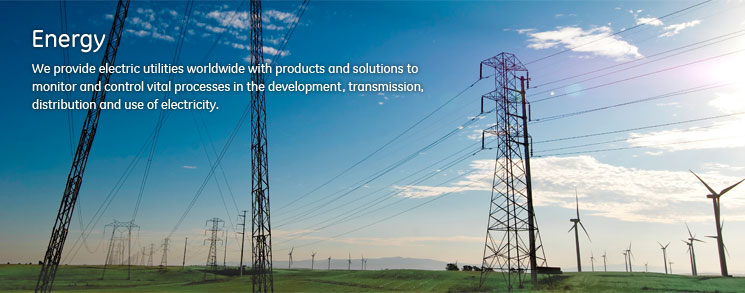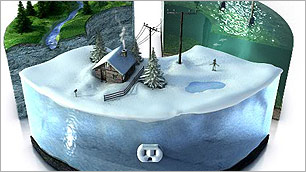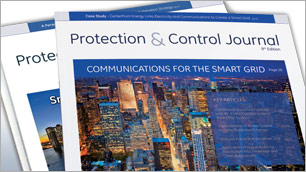-

Real. Reliable. Solutions.
Power Interruptions cost European Union businesses €150 billion each year. Outages cost the U.S. economy an average of $1.5 billion each week – $80 billion, with a 'B' each year. They cost utilities in penalties, repairs, overtime and customer service. GE's smart grid technologies deliver dramatic reliability gains.
With smarter networks, focused maintenance, better understanding and greater load control, you have what it takes to prevent outages. There are technologies to anticipate and prevent problems before they happen. And when unplanned outages do occur, smart grid outage management systems can reroute power to minimize the outage, analyze needed repairs and dispatch crews more effectively to get the job done faster and more efficiently. |
 |

When Great Britain's Office of Gas and Electricity Markets introduced a Quality of Service Interruptions Incentive Scheme, EDF™
Energy provided its GE Distribution Management System (DMS) to cash in on the program's incentives and avoid paying penalties.
EDF Energy, one of the UK's largest energy companies,worked with GE to create automatic fault isolation and rerouting schemes that
utilized the DMS hardware and software already in place. As a result, fewer consumers are affected by outages and service is
restored faster. The system resulted in a 20% reduction in customer interruptions and a 30% reduction in customer minutes lost
in the first 18 months of operation. The cash payoff? EPN received a regulatory performance reward of over £1million.
|

Real. Efficient. Solutions.
The grid is wasting energy at every point during every second of every day – lots of energy. And that costs lots of money. The cost
of generating a kilowatt-hour of electricity is 70 to 170 times the cost of "saving" a kWh through efficiency. GE's smart grid
technologies help reduce the flow of lost energy and wasted money. We have solutions that help lower delivery losses in transmission
and distribution, and technologies that anticipate and monitor demand to help you minimize overcapacity. In the end, consumers and
businesses actually use more of the power you bring into the system. |
|

AEP™ (American Electric Power) is addressing the waste and
inefficiency factors designed into our power delivery model. Utilizing
GE's Coordinated Volt-VAR-Control (CVVC) system, AEP is dynamically
controlling voltage and power factors on feeders to minimize losses
and reduce customer energy consumption. By maintaining power factors
near unity, AEP is reducing reactive power loading. They're applying more real power and lowering reactive power waste – all while
maintaining customer service voltage standards. The bottom line? AEP needs to generate less power to meet the same consumer demand. |

Real. Productive. Solutions.
More than 50% of grid assets are at or approaching the end of their usable life. In the next 10 years, 50% of the grid's skilled workforce will retire – with a critical shortage of replacement workers. GE's smart grid productivity solutions help on both fronts. Asset monitoring, management, maintenance and optimization solutions can keep capital-intensive grid assets on the job beyond their intended lifetimes. Workforce management and field force automation solutions use advanced analytics, communications, and geospatial technology to apply human resources more efficiently and effectively. |
|

Eneco™, one of The Netherlands' leading utility companies, is using
GE Energy's Field Force Automation (FFA) solutions to increase
productivity in its Joulz division – including 500 field workers who
provide construction, maintenance and operations services on
distribution grids. Since the introduction of GE's FFA solution, Eneco
has reported outstanding results, including significant productivity improvements for office personnel and field workers. Yearly inspections are now completed by March instead of December and maintenance work previously completed around year-end is now completed around September. The initiative has delivered an additional benefit, not originally anticipated: significantly increased revenue from more accurate billing and invoicing. |

Real. Clean. Solutions.
Climate change is going to lead to economic change. Because today 40% of the planet's CO2 emissions come from power generation. By 2020 Europe has committed to cut its greenhouse gas emissions by 20 percent, produce 20 percent of its energy from renewable sources and increase energy efficiency by 20 percent. As carbon legislation becomes reality, GE smart grid customers will have an advantage. Our efficiency technologies reduce waste in the system. And we can help optimize renewables to add more clean wind, solar and biomass in the generation mix – enabling more domestic clean energy sources. That means less reliance on the volatility of imported fuels and greater energy independence and security. |
 |

The Hawaiian Islands are aggressively moving from their 80%-fossil-fuel-dependent energy generation to more renewable, carbon-free solutions. GE is working with the U.S. Department of Energy, Hawaii Natural Energy Institute, Maui Electric Company and Hawaiian Electric Company to deliver smart grid solutions that will help see 40% of Hawaii's electricity coming from clean renewable energy sources by 2030. Hawaii's holistic solution deployment includes the demonstration of increased solar and wind integration features through GE's Distribution Management System. The deployment is also rolling out technology breakthroughs in energy storage and other renewables-integration features to maximize the useable energy from Hawaii's vast renewable resources. At the same time, GE will demonstrate peak load management with Demand Response systems and VOLT/VAR technologies to reduce the need for peaking generation and help manage the integration of wind and solar power. The project is looking to reduce peak load in a substation by 15% and help enable higher penetrations of renewable energy in Maui.
|

Real. Consumer-Empowering. Solutions.
For the first time in the 100+ years of an electrified world, consumers can finally understand how their habits directly affect their energy consumption. And it makes a difference. A number of international studies have shown that real-time smart grid pricing information changed consumer behavior and helped reduce household electricity costs by up to 10% and lower peak-time consumption by 15%. With information portals and in-home devices, GE's smart grid shows consumers how they can take control of their energy usage without sacrificing lifestyle. |
|

Louisville, Kentucky consumers are improving their energy profiles
without sacrificing lifestyles. GE smart appliances in homes equipped
with GE smart meters are helping consumers understand their energy use and make decisions that save energy and money every day. Smart appliances are also lowering peak power demands by moving high-energy-consumption activities, such as freezer defrost cycles, to off-peak times.
|

Real. Load-Smoothing. Solutions.
As energy demand continues to grow, so will the need for investment
in peaking resources that are rarely used, yet need to be available. That contributes to skyrocketing energy costs – between 2000 and 2007, electric rates increased an average of 42 percent in the US and 105% in the UK. With worldwide energy demand forecasted to double by 2030 it's only going to get worse. GE is smoothing the demand peaks and valleys with demand response solutions, consumer empowerment tools and voltage reducing Volt/VAR technologies to lower peak demand and better manage loads around the clock. |
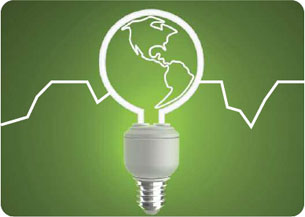 |

The world's largest Marine Corps base uses GE's smart microgrid to
handle on-site power generation and energy storage, while
simultaneously interacting with the local electric grid. Advanced network
control and communications smoothes load requirements by lowering
peaking demand and integrating power from the grid and on-site storage as needed. The solution also enhances the base's ability to add renewable resources, shrinking its carbon footprint and increasing its energy independence. |

Real. Secure. Solutions.
Moving information is as important as moving power in the smart grid. GE has made the securing of private fiber optic,wireless and Ethernet communication networks a cornerstone strategy to aid in eliminating cyber risks .We're actively involved with the National Institute of Standards and Technology (NIST) initiatives to standardize and
optimize smart grid security. We work with the world's leading IT security experts to design systems that resist outside influences, detect tampering and follow strict protocol – to keep information and energy flowing safely. And GE is employing technology and protocols to help ensure data transmitted across the smart grid remains private. |
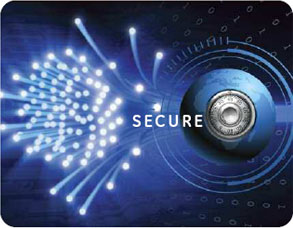 |

CenterPoint Energy in Houston, Texas, relies on GE's cyber-security
enabled WiMAX wireless radios, engineering services, and technical
support for its AMS communications network that connects meter
collection devices to CenterPoint Energy's private network. This rugged,
secure, two way communications solution uses 128-bit encryption to protect data in transit and an array of authentication tools to secure data at points throughout the network. GE gets the right data to the right destinations without interception,misdirection or tampering.
|

Real. Financial. Solutions.
A grid isn't really all that smart if it doesn't make financial sense. GE's smart grid solutions deliver payback in efficiency,
reliability, capital-cost reduction and asset utilization. We also have the financial resources and financing solutions to help
throughout your smart grid deployment. So you have smarter ways to pay for the solutions that help you:
- Maximize your assets' productive life cycles
- Lower labor costs
- Reduce the need for new equipment
- Even the peaks in demand, so you maximize the use of generation
- Solve problems with maintenance instead of repair
|
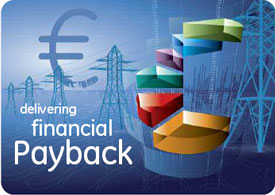 |

Financial benefits of smart grid technology are wide-ranging and significant. Here are a few of the gains smart-grid communities
can expect:
- Improved maintenance and asset management lengthens asset life and defers capital expenditures.
- Efficiency gains result in more of the power generated being consumed by paying customers.
- Load leveling reduces the need for new generation while shifting consumption to non-peak times –maximizing the profitable
capacity of current assets
- Field Force Automation increases worker productivity, speeds repairs and reduces downtime
|
|










